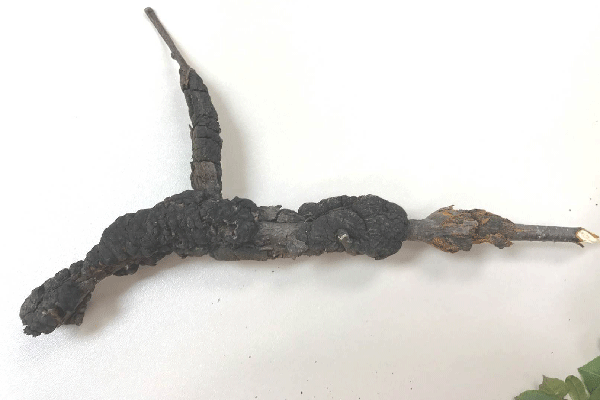As you begin pruning this spring, keep an eye out for a common problem found on plants in the stone fruit family called Black Knot. It’s a widespread fungal disease that affects plum and cherry, and occasionally infects apricots, peaches and other plants in the Prunus genus, like chokecherry. Black knot is common throughout Nebraska in wild plum thickets and gets progressively worse each year unless controlled. This disease is fairly easy to detect, with the most obvious signs being the hard, black, swollen galls, commonly called knots, on branches and twigs (Fig. 1).
 Spring growth of black knot. Note the velvety green fungal growth in the upper right hand quadrant. Photo by Ginny Koranda, Seward County Extension office.
Spring growth of black knot. Note the velvety green fungal growth in the upper right hand quadrant. Photo by Ginny Koranda, Seward County Extension office. Symptoms
The disease in characterized by hard, elongated, black swellings that develop on infected plants. Black knot fungus infects fruiting spurs, stems and branches of susceptible plants, and occasionally the main trunk is affected. Infection occurs through splashing or wind blown spores when new growth is about 1 inch long. Fungal spores are discharged in moderate to heavy amounts during the pink blossom stage of cherry or plum, and ends about the time elongation of the new growth stops. Most infections occur under wet conditions with temperatures between 55-77 F.
On infected plant parts, abnormal growth of bark and wood tissues produce small, light-brown swellings that eventually rupture as they enlarge. In late spring, the rapidly growing young knots have a soft (pulpy) texture and become covered with a velvety, olive-green growth of the fungus.
During summer, the young knots turn darker and elongate. By fall, they become hard, brittle, rough and black. The following growing season, the knots enlarge and gradually encircle the twig or branch. The cylindrical or spindle-shaped knots may vary from one-half inch to a foot or more in length and up to 2 inches in diameter. The conspicuous black gall does not appear until the second year of infection.
Small knots may emerge from larger knots forming extensive galls. After the second year, the black knot fungus usually dies and the gall is invaded by secondary fungi that give old knots a white or pinkish color during the summer.
As the knots grow they eventually cut off the flow of water and nutrients to the branches, causing stunting, wilting, and dieback. Smaller twigs usually die within a year after being infected. Larger branches may live for several years before being girdled and killed by the fungus. The entire tree may gradually weaken and die if the severity of the disease increases and effective control measures are not taken.
Management
The two major plum varieties grown in Nebraska ‘Stanley' and ‘Damson', are susceptible to this disease, as well as ‘Bluefire' and ‘Shropshire'. ‘Methley', ‘Milton', ‘Early Italian', ‘Brodshaw' and ‘Fellenburg' are moderately susceptible; and ‘Shiro', ‘Santa Rosa', and ‘Formosa' are only slightly susceptible. 'President' is apparently resistant to black knot. Japanese varieties of plums are generally less susceptible than most American varieties.
Among ornamental landscape plants within the Prunus family, ‘Canada Red’ cherry and ‘Schubert’ chokecherry are often affected, along with other cultivars.
Avoid planting new plum or cherry trees next to or downwind from an old or abandoned orchard with a significant black knot problem. Similarly, remove all wild plum and cherry trees, which are a potential disease reservoir, from fencerows or woodlands within 600 feet of the orchard site. Established orchards or backyard trees should be scouted or examined each year for the presence of black knot, and infected twigs should be pruned out and destroyed or removed before bud break.
Pruning is the most important control measure, and can reduce infection by 80%. Knots should be pruned in late winter or early spring before growth starts. It is important to prune at least 2-4 inches below each knot because the fungus grows beyond the edge of the knot itself. Pruning tools should be sterilized between cuts. Pruned plant material should be buried, burned, or composted.
If pruning is not possible because knots are present on major scaffold limbs or the trunk, they can be removed by cutting away the diseased tissue down to healthy wood and out at least 1/2 inch beyond the edge of the knot. Burn or bury the prunings before April 1st.
Fungicides can offer significant protection against black knot, but are unlikely to be effective if pruning and sanitation are ignored. Fungicides are most necessary and will provide the greatest benefit if applied before rainy periods, particularly when temperatures are greater than 55 degrees F. In evaluating control programs, remember that knots often do not become apparent until the year following infection.
For more information, view:
Black Knot of Plums and Cherries, Ohio State University
Black Knot of Ornamental Cherry & Plum, The Morton Arboretum

